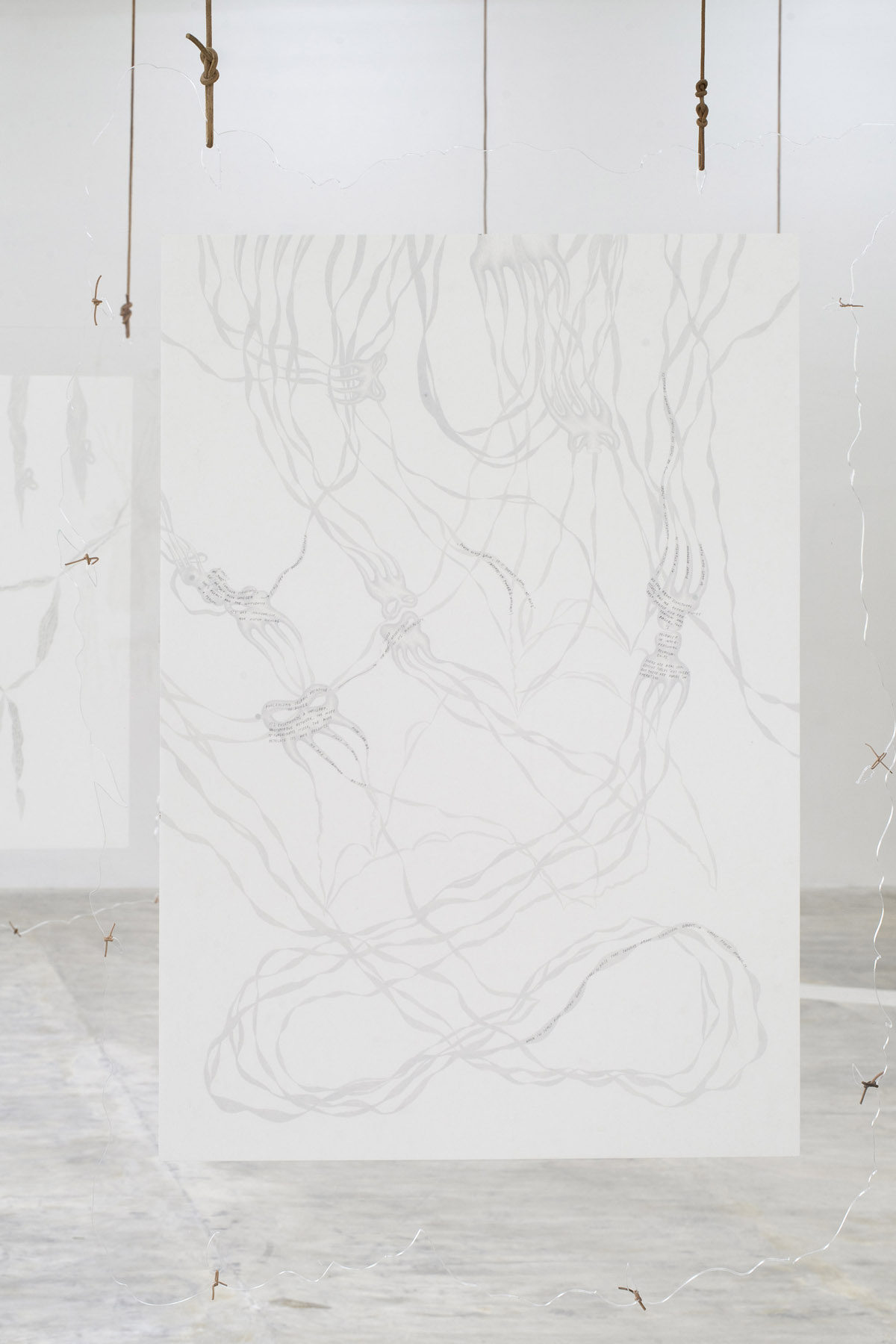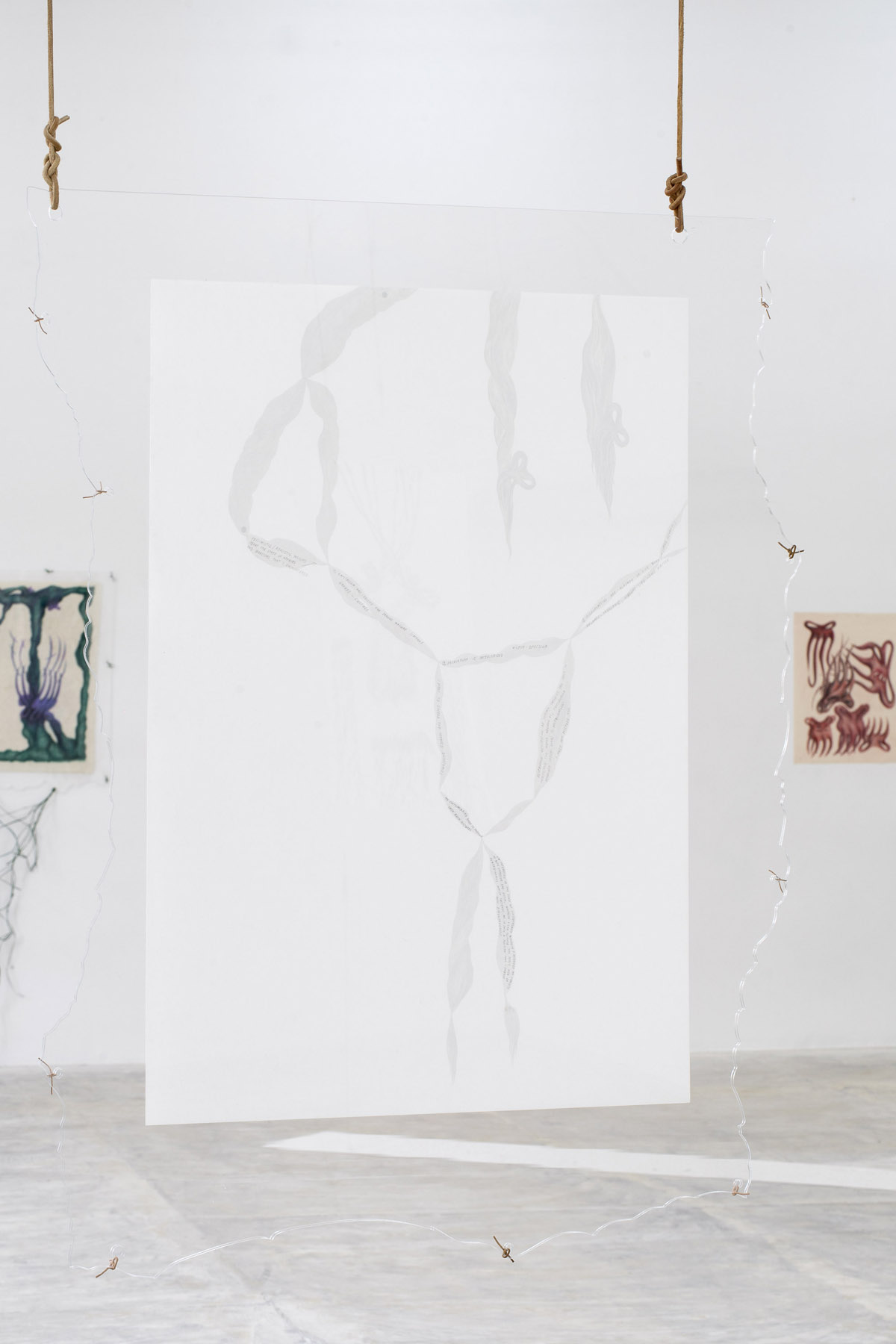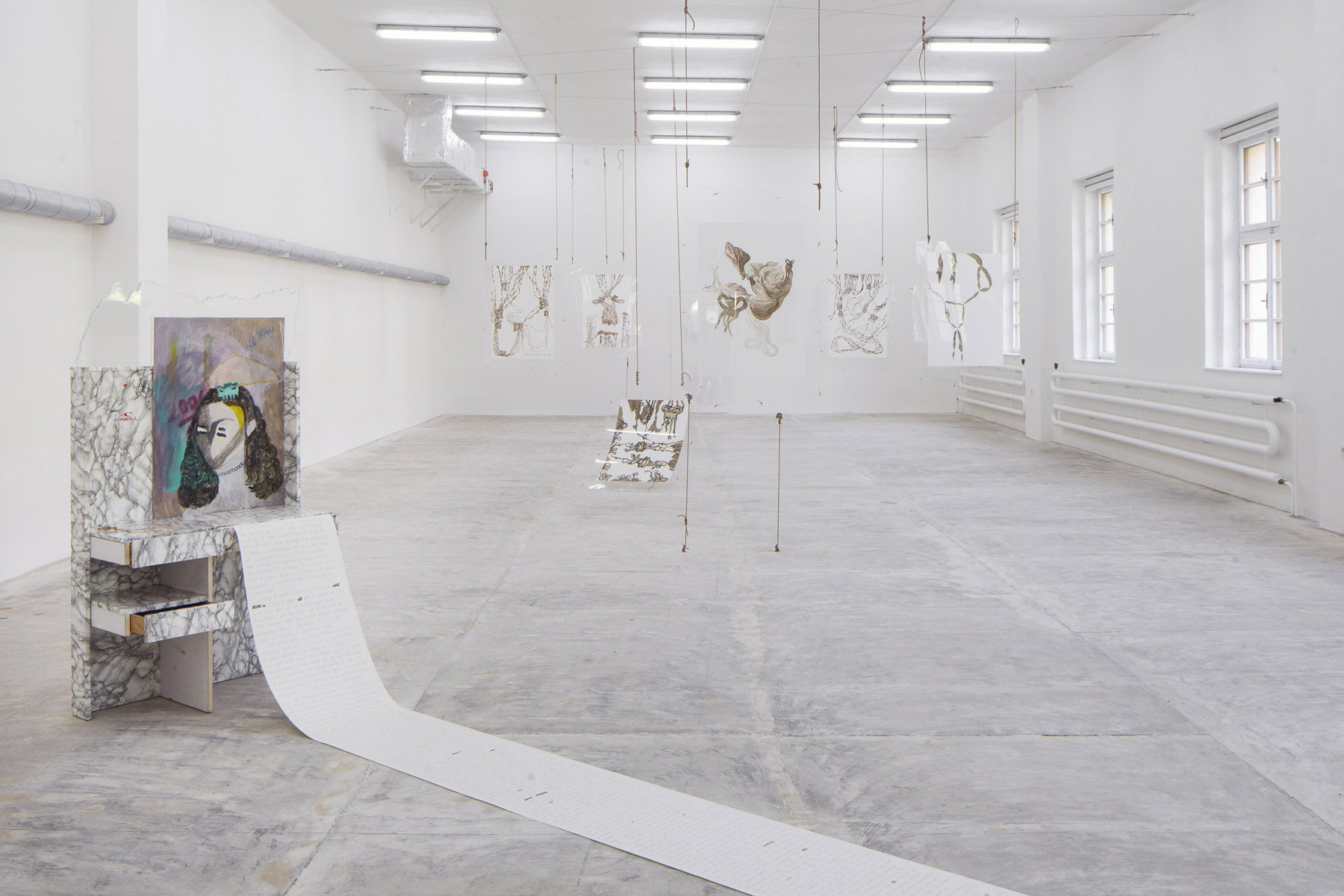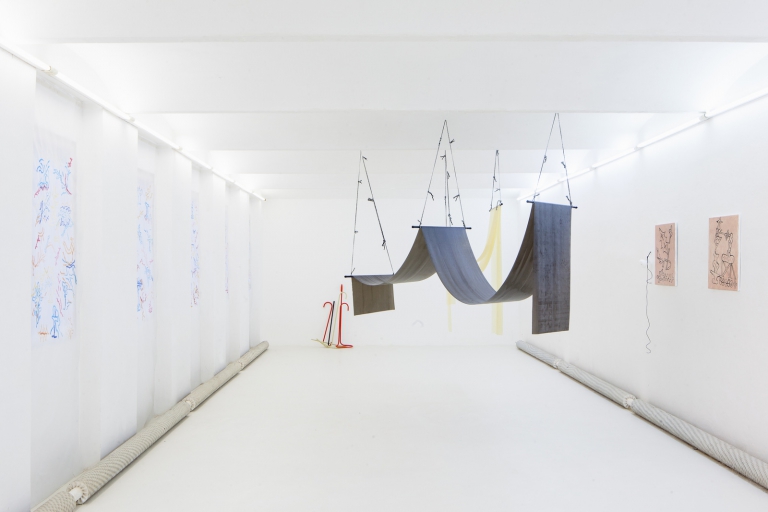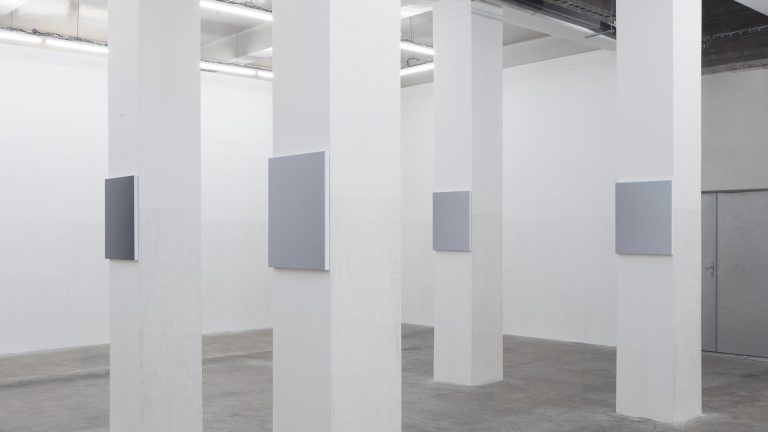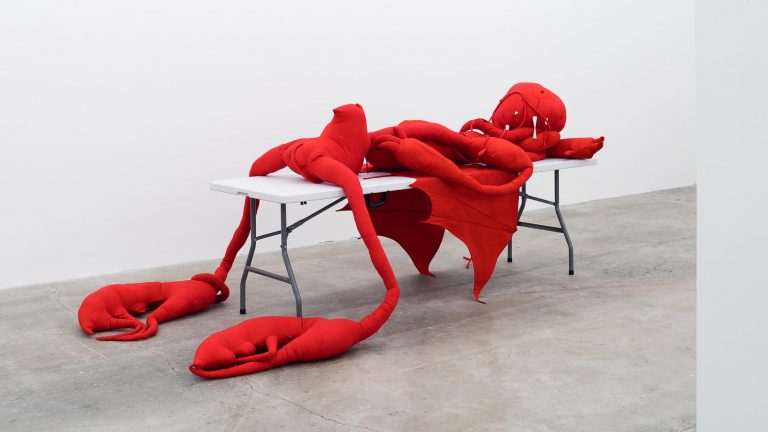Artist: Dominika Trapp
Exhibition title: Power must grow, if it doesn’t grow it rots
Curated by: Caroline Krzyszton
Venue: Karlin Studios, Prague, The Czech Republic
Date: September 8 – October 2, 2020
Photography: all images copyright and courtesy of the artist and Karlin Studios, Prague
In 1964, on his TV show Zur Person, the German journalist Günther Gauss asked Hannah Arendt if she wanted to exert influence with her work, she replied: “To be perfectly honest, I will say that when I work, I am not concerned with action or efficiency. (…) You know, the main thing for me is to understand: I have to understand. Writing, for me, is also part of this understanding. Writing is part of the comprehension process, isn’t it? (…) – if I may be ironic – (influence is) an entirely masculine question. Men always have a terrible urge to exert influence, but I see it, in a way, from the outside. Me, try to influence? No, I want to understand. And when others understand -in the same way I have understood- then I feel gratification, like a sense of home.”
There is no elusiveness in the fact that Dominika Trapp chose a quote from Hannah Arendt as the title for her exhibition. And one could even trace a connection between Arendt’s obsession for a certain neutrality or objectivism in her analysis of power relations and Dominika’s perception of the multi-layered pattern of responsibilities in human actions – later becoming societal organizations, inducing different levels of interpretation.
Dominika Trapp is a young Hungarian artist and curator who recently focused her research on orthorexia nervosa and cultural-historical aspects of various eating disorders experienced by women. In her last project, she also researched the role of women in the Hungarian folklore / peasant culture and its critical interpretation in traditionalism and nationalism. For her exhibition at Karlin Studios, Dominika Trapp examines however her own personal experience to express rather controversial and intuitive thoughts on feminist theories. Using the painting as an ultimate medium of a somatic experience, she addresses a profound need of healing through the power of interpretation and re-appropriation of the body.
Both Arendt and Trapp’s reflections aren’t preparatory to any discussion, and are not intended to build any majority. They are part of a conversation that is distinguished by its openness and engaged in the common space of understanding. No altercation between ready-made ideas, no dialectics, rather a collection of experiences, and, in the case of Dominika Trapp, a research of “body truth”. (Caroline Krzyszton)
« The claw clip appeared in a painting of mine for the first time ten years ago. Eighth Grade Class Trip depicts a girl in 90s fashion and accessories. Through this painting and others in the series I processed my coming of age experiences as a woman in a small countryside town. Again, later, I worked with the clip motif in my Unio Plastica series, which reflects on the union of the organic and the inorganic by borrowing the religious concept of unio mystica. I aim in my new works to explore the layers of meaning and the genealogy of the claw clip as a symbol in my own practice by using intuitive painting as a research method.
Based on the narrative of the Unio Plastica series, I started by playing with two agonists: the hair clip as an invasive agent, and less conscious organic masses. In my paintings I never sketch or trace, and in these works this allowed interactions between these characters to emerge intuitively. Simultaneously, I took notes – often emotional ones – that I later analysed and collected on the back of each painting.
After weeks of painting and listening to lectures about the notion of power by Hannah Arendt, I started to see parallels between the emerging interactions in my paintings and my ambivalent experiences within radical feminist circles. Following my path of research into power dynamics, ideology, and the body that began with Arendt, I started to reread Simone Weil. Through revisiting her ideas I saw the hairclip as a symbol of an ideology that, in the words of Weil, creates readings for me by organizing reality into peculiar shapes – most of which I now couldn’t accept as my “truth” anymore.
My relationship with feminism spans exactly 10 years. At the age of twenty-two, at the Budapest – Kőbánya Kispest railway station, after a nasty break-up, I was sitting on a crowded, stuffy train, heading to my hometown, staring exhausted out the window when I saw a young, hunched woman on the platform. She didn’t have many packages except for her own breasts, the carrying of which apparently burdened her. Perhaps my own self-pity made me so sensitive , or it was a case of the weilian attention, that the ordinary scene suddenly became a manifestation of a peculiarly feminine nature of suffering in my eyes, which I felt at the time was inextricably linked to biological determinations. I burst into tears, filled with compassion that turned into a sense of belonging together that I had never experienced before.
It was this revelatory – I might even say somewhat Mystical – experience that led me to make my first works of art from an emphasized female perspective, part of which is the Eighth Grade Class Trip.
It is no coincidence that the feeling of female solidarity developed in me in relation to the experience of the female body as a burden. With the history of teenage orthorexia nervosa behind my back, I have fought many fights against my body that I should have fought against individuals, or against the existing social order. I later understood these structural aspects of my condition through feminist theories, that I am not fighting my struggles alone. Although I have used feminist methodologies in several of my works later on – including my own exhibition Dazed and Orthorexic, which addressed female eating disorders in a historical context – feminism was not explicitly part of my identity. I began to refer to myself as a feminist around the time when the conservative Hungarian government first articulated open criticism against female emancipation. Rather than a revolutionary act, today I see this self-labeling partially as a symptom of having no real means against power.
In the following years, as the MeToo movement swept through Hungary, I began to reevaluate traumas I had already attempted to process – moreover, I was right in the middle of repeating one. I sought help in activist circles and eventually a radical feminist self-knowledge/reading group. Our bi-weekly discussions revolved around the topics of sex-related traumas, the effect of porn on sexuality and the accompanying (mostly second wave-feminist) literature. During the one year I participated, the critical language of feminism transformed into a therapeutic jargon. This theory, one through which I had previously tried to understand the world and my position in it, was reclassified as my dominant worldview and in it I recognized myself as a victim of patriarchal oppression. Accepting myself as a victim was a crucial part of the therapeutic process – “it was not your fault” -, identifying as such and belonging to a group of people on this basis had a limiting effect on my thinking, eventually. Recognition has the potential to consolidate identity, but to do so also freezes the idea of an order in which identity can gain its role. No matter how liberating the mission of a movement is, if its practical operation is dogmatic and its rhetoric is divisive, calcifying — the germs of oppression are in it. After several occasions, some kind of internal resistance began to grow in me that made me ashamed of myself. The aims of the self-knowledge group was to liberate me from bodily trauma, but in ways that I explore in this exhibition, they also imposed the burden of a normative ideology. This burden affected not just my relationship with my own sexuality, but my ability to articulate transgressive insights. To formulate criticism, even in the form of confessing my cognitive dissonances, I felt it would have jeopardized not only the stability of my identity as I understood it, but also the common feminist cause.
In my previous exhibition, I examined peasant women’s traumatic autobiographies from a very committed feminist perspective. I was interested in the amount of agency provided to women in peasant communities, and in what individual ways women transgressed certain rules or formulated self-reflection to gain more. Although my exhibition at first reading was like feminist course work – which provoked the anger of the Hungarian right-wing press –, today I see that it continued the aspirations of my previous exhibitions: an examination of control – let it be self-imposed or external – and the individual will that confronted it. And although this was not clear to me at the time, from the perspective of my current project, I see that it also took a stand against the normative quality in my own feminism.
The ideology that is thrown as a life preserver is difficult to be viewed from a critical distance as it serves one’s survival to cling to it. Trauma processing is the path of practice, i.e. the practical application of the offered narrative, which eventually leads towards a personal truth – to a life beyond trauma.
In her late writings about somatic practice, Weil describes the world as a text that can be read on a variety of levels. Readings can affect us as concretely and as involuntarily as a fist-blow to the stomach, and they reveal a world that is shot through with values of all kinds. These values make especially apparent the self-referring quality of our readings. “Texts of which the appearances are written characters take hold of my soul, release it, are replaced by others; are some worth more than others? Are some more true than others? Where is one to find a standard?’’ – she asks. In evaluating the value, truth, or morality of an action, desire, or object what we need to do is evaluate not the thing itself but our reading of it, and we must ask by what means we can pass from one reading to another. Eager to find a cure to this uprootedness, she sought a somatic practice that might affect an interpretive shift towards a morally and spiritually balanced perspective; she accomplished this passing by letting the body mediate, by letting the body become the roots. The most obvious metaphors of this embodied intelligence are present in our languages too: gut-feeling/Bauchgefühl etc. These are reporting us from synchronous events, which are already present on our horizon. In these events the external reality demands from us an answer, a responsible act.
Following Weil’s path, I gave voice to my somatic intelligence, my gut feeling, by way of painting – conveying a specific message developed by both my mind and my body. In this way I aim to explore my authentic relationship to feminism, and seek the answer for the question: What is artistic intuition and creativity, or more explicitly: how does the experimental practice of somatic intelligence emancipate creative and responsible will-power and freedom?
However critical I seem to be, I did not intend with this exhibition to take an anti-feminist position. We are accustomed to the idea that the political resolutions of an individual are precise and unambiguous; uncertainty, except when tactical, is a handicap in the political arena. And while art occasionally becomes a server of political agendas, it still provides a venue for controversial insights and self-reflection – for making visible ideas in their nascent stages, and the way in which one aspires to realize them.
To put something in the light of consciousness – according to the Weilian analysis of András Borbély, Transylvaninan poet – it also means to look at it from a certain distance. Distance at the same time means being in a free relationship with it, not being tied to the compulsion of a need. However, distance is a case of the relation of those who are far apart, so it is also a relationship, i.e. closeness.
In light of this, I consider my self-reflection and my critical position as an act of care – caring for myself and for the feminist movement among others. » (Dominika Trapp)








